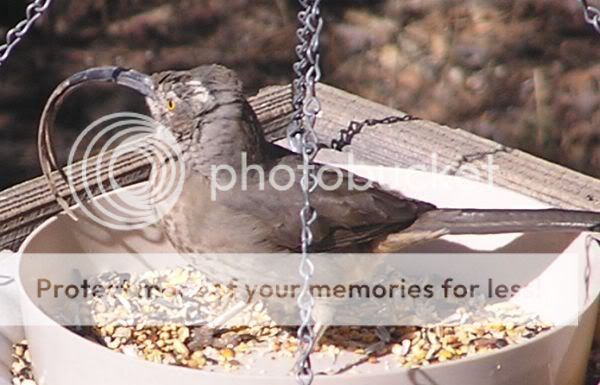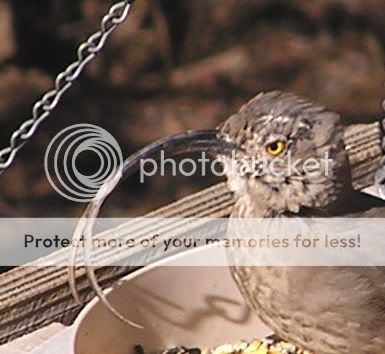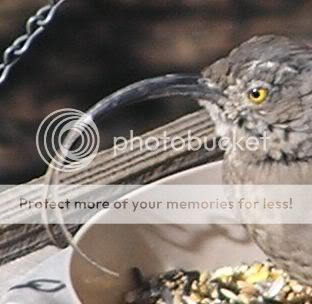It looks like you're using an Ad Blocker.
Please white-list or disable AboveTopSecret.com in your ad-blocking tool.
Thank you.
Some features of ATS will be disabled while you continue to use an ad-blocker.
8
share:
This guy has been showing up at our feeder. He's obviously found a way to eat as he twists his head to pick up seeds... Very odd little critter.
We have a bird here called the curved-bill Thrasher, but this beak goes WAY beyond that! Has anyone seen a bird like this?



We have a bird here called the curved-bill Thrasher, but this beak goes WAY beyond that! Has anyone seen a bird like this?



How bizarre, maybe he is trying to make a fashion statement for the lady birds.
By the way, awesome pictures. How did you manage to get so close and not frighten it off?
By the way, awesome pictures. How did you manage to get so close and not frighten it off?
edit on 1-2-2012 by mileysubet because: (no reason
given)
The gene pool over-floweth. This little guy got more than his fair share. Glad he adapted and can eat. Glad you feed him.
TY for the photos.....
TY for the photos.....
Looks like a curved bill thrasher with an unusually long beak. They're also desert birds and you're in Canada, if I remember correctly so, I may be
wrong but, he sure does look just like the bird type in your pics.

Wiki

Curve-billed Thrasher
The Curve-billed Thrasher is generally 25 to 28 cm (10 to 12 inches) long, slender in build with a long tail, and a long, curved, sickle-shaped bill. It is pale grayish-brown above with lighter-colored underparts that are vaguely streaked. The tips of the tail are streaked with white, and the sides of the tail are a darker color than its back. The eye of an adult is usually a vivid orange or red-orange, although immature birds have a yellow eye.
The Curve-billed Thrasher is commonly found throughout the deserts and brush-filled areas of the south-western United States, from about the Sonoran Desert of Arizona and across New Mexico to west Texas, as well as most of Mexico, from the Sonoran-Chihuahuan Deserts and south through the Mexican Plateau to regions south of the Trans-Mexican Volcanic Belt in south-central Mexico.
Wiki
edit on 2/1/12 by FortAnthem because: _________ extra DIV
That is definitely a curve-billed thrasher with a bill deformity. (I took ornithology in college, a wildlife biology major) Check out this link:
www.rrbo.org...
www.rrbo.org...
edit on 1-2-2012 by Muttley2012 because: (no reason given)
reply to post by FortAnthem
Yes, we have curved bill thrashers and his yellow eye made me think he was one. But he's smaller than most we see. (I'm in New Mexico, not Canada, although I'd love to visit!) I suppose this irregularity could be associated with his size.
Someone on my dog board said that for some reason, he hasn't been trimming his beak, which is something wild birds usually do. Some captive birds have to have their beaks trimmed... Maybe this guy just has a birth defect or injury that prevents him from trimming his beak properly.
I have an email into a biologist friend of ours and I'm sure he'll have some input, too. I'll post back after I hear from him.
Thanks for the comments!
Yes, we have curved bill thrashers and his yellow eye made me think he was one. But he's smaller than most we see. (I'm in New Mexico, not Canada, although I'd love to visit!) I suppose this irregularity could be associated with his size.
Someone on my dog board said that for some reason, he hasn't been trimming his beak, which is something wild birds usually do. Some captive birds have to have their beaks trimmed... Maybe this guy just has a birth defect or injury that prevents him from trimming his beak properly.
I have an email into a biologist friend of ours and I'm sure he'll have some input, too. I'll post back after I hear from him.
Thanks for the comments!
reply to post by mileysubet
I took these from the second story window of our living room. Zoomed in all the way.
I took these from the second story window of our living room. Zoomed in all the way.
This story just went conspiracy...
Deformed Beaks May Signal a Greater Environmental Problem
I found more pics of examples of birds with deformed beaks but none this 'bad"...
www.flickr.com...@N03/5386603212/lightbox/
Deformed Beaks May Signal a Greater Environmental Problem
In birds affected by what scientists have termed “avian keratin disorder,” the keratin layer of the beak becomes overgrown, resulting in noticeably elongated and often crossed beaks, sometimes accompanied by abnormal skin, legs, feet, claws and feathers.
...
“The prevalence of these strange deformities is more than ten times what is normally expected in a wild bird population,” said research biologist Colleen Handel with the USGS, “We have seen effects not only on the birds’ survival rates, but also on their ability to reproduce and raise young. We are particularly concerned because we have not yet been able to determine the cause, despite testing for the most likely culprits.”
The disorder, which has increased dramatically over the past decade, affects 6.5 percent of adult Black-capped Chickadees in Alaska annually.
I found more pics of examples of birds with deformed beaks but none this 'bad"...
www.flickr.com...@N03/5386603212/lightbox/
new topics
-
Hate makes for strange bedfellows
US Political Madness: 1 hours ago -
Who guards the guards
US Political Madness: 3 hours ago -
Has Tesla manipulated data logs to cover up auto pilot crash?
Automotive Discussion: 5 hours ago -
whistleblower Captain Bill Uhouse on the Kingman UFO recovery
Aliens and UFOs: 10 hours ago
top topics
-
CIA botched its handling of sexual assault allegations, House intel report says
Breaking Alternative News: 15 hours ago, 11 flags -
whistleblower Captain Bill Uhouse on the Kingman UFO recovery
Aliens and UFOs: 10 hours ago, 10 flags -
Who guards the guards
US Political Madness: 3 hours ago, 7 flags -
Hate makes for strange bedfellows
US Political Madness: 1 hours ago, 6 flags -
1980s Arcade
General Chit Chat: 12 hours ago, 5 flags -
Teenager makes chess history becoming the youngest challenger for the world championship crown
Other Current Events: 14 hours ago, 4 flags -
Deadpool and Wolverine
Movies: 13 hours ago, 4 flags -
Has Tesla manipulated data logs to cover up auto pilot crash?
Automotive Discussion: 5 hours ago, 2 flags
active topics
-
"We're All Hamas" Heard at Columbia University Protests
Social Issues and Civil Unrest • 224 • : namehere -
Candidate TRUMP Now Has Crazy Judge JUAN MERCHAN After Him - The Stormy Daniels Hush-Money Case.
Political Conspiracies • 662 • : network dude -
Hate makes for strange bedfellows
US Political Madness • 9 • : crayzeed -
Deadpool and Wolverine
Movies • 3 • : 5thHead -
IDF Intel Chief Resigns Over Hamas attack
Middle East Issues • 38 • : HopeForTheFuture -
Europe declares war on Russia?
World War Three • 62 • : 777Vader -
1980s Arcade
General Chit Chat • 13 • : Bluntone22 -
British TV Presenter Refuses To Use Guest's Preferred Pronouns
Education and Media • 110 • : Annee -
Michael Avenatti Says He Will Testify FOR Trump
US Political Madness • 61 • : JadedGhost -
Who guards the guards
US Political Madness • 2 • : budzprime69
8
